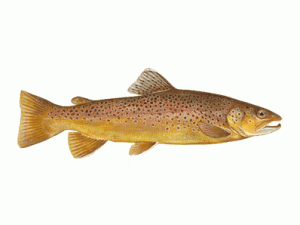Highly prized for their size, fighting ability and table quality, brown trout are popular among fly fishermen around the world. Browns are considered to be among the most challenging trout species to catch.
Brown trout vary greatly in appearance. Most adult fish are olive green to brown above, fading to creamy, golden-yellow along the flanks with off-white undersides. Most brown trout display black spots along their sides, back and dorsal fin. Each spot is surrounded by a lighter colored halo. Individuals usually do not have spots on the tail.
The brown trout’s scientific name translates to “trout-salmon.” This trout belongs to the genus Salmo, which also includes Atlantic salmon and other species.
Brown trout were introduced to North American lakes and streams in the 19th century. Brown trout thrived, and have become firmly established in the northern U.S., Great Lakes Basin, eastern streams and other areas.
Anadromous members of the species are called sea trout. Young sea trout grow in rivers before migrating out to sea. Adults return to their home waterways to spawn, repeating the life cycle. North American sea trout are thought to prefer less extensive feeding excursions into estuarine waters. In contrast, European stocks often undertake extended migrations into oceanic environments.
In lakes, brown trout often reach weights of 8 pounds or more. Some individuals grow much larger. The world record brown trout is shared by 2 fish, both of which exceeded 41 pounds.
Brown trout x brook trout hybrids are known as tiger trout.
Related Information
